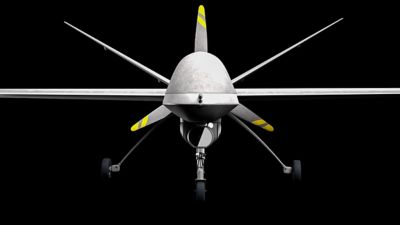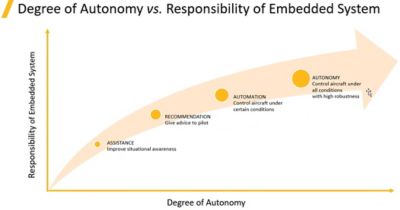-
United States -
United Kingdom -
India -
France -
Deutschland -
Italia -
日本 -
대한민국 -
中国 -
台灣
-
Ansys s'engage à préparer les étudiants d'aujourd'hui à la réussite, en leur fournissant gratuitement un logiciel de simulation.
-
Ansys s'engage à préparer les étudiants d'aujourd'hui à la réussite, en leur fournissant gratuitement un logiciel de simulation.
-
Ansys s'engage à préparer les étudiants d'aujourd'hui à la réussite, en leur fournissant gratuitement un logiciel de simulation.
-
Contactez-nous -
Carrières -
Étudiants et universitaires -
-
S'inscrire -
Déconnexion -
Espace client -
Support -
Communautés partenaires -
Contacter le service commercial
Pour les États-Unis et le Canada
+1 844.462.6797
-
ANSYS BLOG
September 15, 2023
On the Flight Path: How Simulation is Shaping the Future of Autonomy in Aerospace and Defense
There’s a lot of buzz around self-driving vehicles — even those that can fly. In aerospace and defense (A&D), autonomous aircraft will soon take to the skies to deliver a faster, cheaper, cleaner, safer, more integrated means of transportation. And it will without a doubt revolutionize defense and commercial aerospace industries. With numerous applications in defense and civilian sectors, full autonomy will change the way air mobility is perceived today.
Similar to other applications, the defense industry usually is the pioneering force behind major aerospace inventions, however, the spillover benefits can certainly be seen in commercial aerospace as well. While the defense industry has already developed capable unmanned drones, only early levels of autonomy functions —like pilot assistance systems — can be seen in today’s commercial aircraft.
Benefits of Autonomy in Defense
There are numerous benefits that the defense industry stands to gain with higher levels of autonomy. Benefits such as:
- Mission efficiency: Defense missions are often time sensitive, and greater efficiency is more of a necessity than a benefit. With higher levels of automation comes greater accuracy as autonomous systems are much more precise in performing predefined tasks and missions compared to their human counterparts.
- Lower risk: Missions often involve high risk activities such as search and rescue in unfriendly environments, and handling and disposal of hazardous materials. Any level of autonomy that reduces the human presence and physical boots on the ground to perform dangerous actions certainly lowers the risk factors involved.
- Endurance: Long duration missions can increase fatigue, raising the overall level of risk. The endurance of autonomous machines for long duration missions — like search and rescue — is highly valuable.
- Scalability: Autonomous systems can work independently or networked together to perform in cohorts, depending on the nature of the exercise. The ability to jointly work together with pinpoint precision greatly enhances flexibility, scalability, and efficiency all while lowering execution time.
- Faster response time: Autonomous systems enable processing of large data sets under real-time conditions. Near instantaneous processing of raw data and the subsequent instantaneous decisions far supersede human capabilities in any given condition.
To examine and understand the need for and importance of autonomy in aviation, it is important to first understand the different applications where higher levels of autonomy can truly make a difference.
Importance of Autonomy in A&D: Defense Applications
- Air vehicle management systems (AVMS): In the defense industry, these refer to integrated systems and technologies that are deployed to manage and control unmanned aerial vehicles and drones. AVMS are used to control and automate tasks such as takeoff, landing, and mission execution. These critical systems are also responsible for maintaining communication with control stations, monitoring health, performing diagnostics, and maintaining cybersecurity.
- Formation flying and swarming: Formation flying and swarming refer to an advanced concept where aircraft fly in a coordinated manner while maintaining a specific distance within a geometric configuration. Formation flying has various applications and benefits such as wide aerial surveillance and inspection, environmental monitoring, and constant communication relay to communicate over large distances.
- Missile threat neutralization: Missile threat neutralization refers to the use of autonomous systems to detect, track, and counter any incoming missile attacks. Systems that are capable of making split second decisions are key to efficient operation of various stages including detection, decision making, countermeasures, launch, interception, and real time adaptation.

Importance of Autonomy in A&D: Commercial Applications
- Pilot assistance systems: Pilot assistance systems can perform various functions such as autopilot, automated navigation, and even evasive maneuvers. Automating routine tasks in the cockpit enables the pilot to focus on making decisions related to critical parameters. As a result, overall safety is enhanced due to elevated situational awareness.
- Autonomous cargo transport: Unmanned cargo transport is another key application. Achieving low-cost logistics solutions where autonomous pods can navigate to remote areas with limited services can add tremendous value to the economy.
- Streamlined air traffic control: Optimizing flight routes with artificial intelligence (AI) aircrafts can tremendously help in reducing air traffic congestion. Higher levels of sustainability can be achieved by optimizing routes that can reduce overall fuel consumption.
- Emergency response: Automated systems can perform certain limited functions in case of an emergency. Because autonomous systems are capable of quickly analyzing the situation, these systems can provide guidance to pilots in emergencies such as engine failures, sudden health issues, and emergency landings.
Get a glimpse into the future of autonomous and connected aircraft system development.
Autonomy in A&D: Today vs. Tomorrow
Like the automotive industry, autonomy in A&D also include multiple levels. These levels can range from assistance and recommendation (like L1 and L2 in automotive) to automation and full autonomy (like L3 to L5 in automotive). The chart below depicts the relationship between the degree of autonomy achieved versus how much responsibility is transferred over to embedded autonomous systems.

As previously stated, there is some level of autonomy built into today’s commercial aircraft — think autopilot systems — but that’s merely scraping the surface of autonomy to perform assistance and recommendation tasks. Although, autopilot systems have been prevalent for a few years and part of most newer generation aircraft, aviation law mandates the presence of at least two trained pilots in the cockpit.
The cost burden associated with this mandate in commercial aviation is a major pain point for aircraft manufactures, and therefore is serving as one of the prominent use cases to lobby for development of safe and secure autonomous systems. With the development and advancement of advanced autonomous systems, the commercial aviation industry may be willing to reduce the mandate to only include one pilot in the cockpit instead of two.
Autonomous Challenges in A&D
The development of autonomous systems in A&D is facing several challenges:
- The applications must operate in complex and uncertain environments and support autonomous and pilot-assistance systems, while guaranteeing system safety.
- The applications must support the design of efficient systems performance such as energy-aware trajectories or area-coverage maximization.
- The perception in complex environment requires a multi-sensor approach.
- The perception training and validation require simulating thousands of scenarios in real time.
- Real flight testing to validate the system and ensure safety and reliability is costly.
How Do We Get Ahead?
Simulation is perhaps the most cost efficient and dependable answer in lieu of extensive in-flight test data that is required to establish a baseline to pass safety and reliability requirements.
Ansys is pivoting to meet these industry demands with Ansys AVxcelerate Sensors, a real-time sensor simulation tool for the development, testing, and validation of sensor perception.
There are a few versatile features that make AVxcelerate an ideal choice for A&D autonomy simulations:
- Accuracy: AVxcelerate provides physics-based accurate sensor simulation. It comes with a full set of parametric sensor models including optical camera, lidar, radar, and thermal camera as well as with user interfaces and interconnectivity to user development and validation ecosystems. AVxcelerate’s physics-based simulation relies on measured material and light properties. It accounts for the multi-spectral aspect of light propagation in real time, thereby enabling the user to simulate real world edge cases like various lighting and extreme weather conditions.
- Toolchain Agnostic: AVxcelerate provides an open architecture with the ability to connect physics-based sensors to any third-party flying simulator via public APIs based on Google Protobuf or grpc standards (programming/scripting in C/C++, .Net or Python).
- Software-in-the-loop (SiL) and Hardware-in-the-loop (HiL) Connectivity: Perception software can be tested both on the host computer with SiL or on the test bench with HiL. Please note, HiL requires the usage of an injection box, which replaces the actual imager with the virtual image.
With advanced simulation tools available today, achieving full autonomy in A&D seems more realistic than ever. To learn more about AVxcelerate, visit Ansys AVxcelerate Sensors | AV Sensor Simulation Software. To learn more about the future of autonomy in aircraft, download this infographic.










